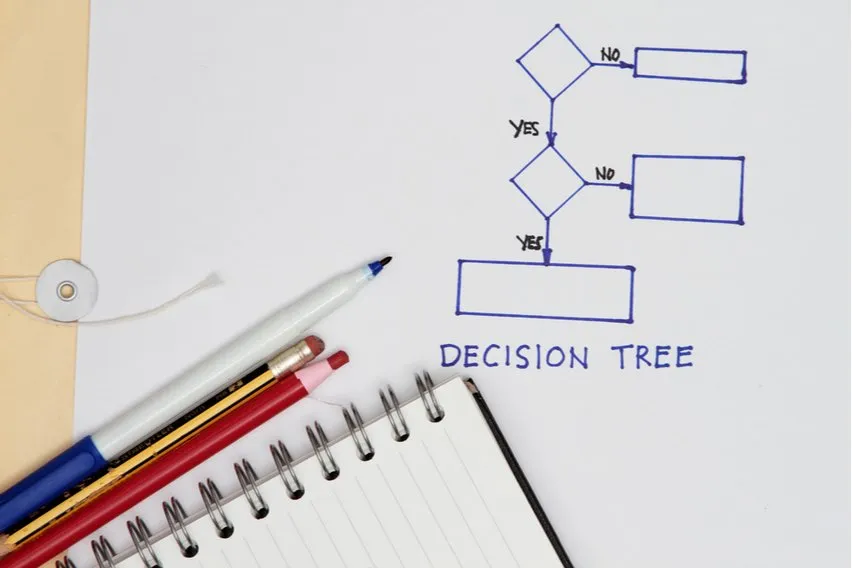What Is a Decision Tree Analysis? Definition, Steps & Examples

Decision trees can help business owners make complex decisions about anything from finances to staffing.
Have you ever heard of the decision tree method? Aside from being an amazing idea for a children’s book, a decision tree is one of the most common methods used by business owners to make a decision.
A decision tree diagram can be used for questions like: “should I upgrade our office chairs?”. Also, “should I hire another salesperson?”, and “should I add gummy bears to the snack bar?” (do you really need a decision tree for that last one?). Decision trees can either be drafted out with a pen or created with a decision tree software program or decision tree maker for that extra bit of accuracy.
Here’s What We’ll Cover:
The 4 Elements of a Decision Tree Analysis
The 4 Elements of a Decision Tree Analysis
A simple decision tree consists of four parts: Decisions, Alternatives, Uncertainties and Values/Payoffs.
Let’s say you are trying to decide if you should put on sunscreen today. The decision would be: “Should I wear sunscreen today”. The alternatives would be: “yes or no”, the uncertainty would be: “the weather” and the payoff would be: “health and happiness”.

1. The Decision
Every good decision tree analysis starts by writing out the initial decision, which in most software programs is represented by a square. If we use the sunscreen decision as an example, it might look something like this:
(the words: “Should I wear sunscreen today?” surrounded by a square)
2. The Alternatives
So now that you’ve written out and boxed your decision, it’s time to add your “alternatives”. Alternatives are the many directions the decision could go in or “future choices”. In this case, there are only two potential outcomes to the question “should I wear sunscreen today” and that’s “yes” and “no”. So now, from your decision box, you would draw two branches, one labelled yes and the other no:
(Add two branches, one labeled yes, one labelled no)
Let’s say your decision is: “what type of business should I open”. This may warrant more than 2 alternatives and in this case, you would have many branches stemming from the decision box.
3. The Uncertainty
Now for the “uncertainty”. In most decision tree analysis software programs, the uncertainty is represented by a circle, but again, any shape will do. In this case, the uncertainty is “the weather” and more specifically “will there be sun?”.
At the end of each branch, write your uncertainty surrounded by a circle (or other shape)
(Add a circle at the end of each branch with the words: will there be sun?)
Now add two more branches stemming out from each circle labeled “yes” and “no”.
(Add two branches to each circle, one labeled “yes” and one labeled “no”)

4. The Value/Payoff
So, what is the payoff for wearing sunscreen? Could it be…happiness and health? So if you decide to “yes” wear sunscreen and “yes” the sun is out, your level of health and happiness will be high. You can assign this level a number that will be useful in analyzing the decision tree once you’re done. So let’s make your happiness/health level a 9, pretty good.
If you decided to wear sunscreen and it’s a cloudy day, your level might be at a 6. Your skin is obviously going to be protected, but you’re kind of annoyed you wasted your $30 sunscreen. Onto the “no” branch.
Now let’s say you didn’t decide to wear sunscreen and the sun is out that day, a risky choice. Your level will be at an all-time low, maybe a 3 and the sunburn doesn’t help. The final alternative is you not wearing sunscreen and no sun in the sky. That might warrant an 8, as you didn’t waste any sunscreen and life stayed pretty much the same.
You can use this decision tree model for any business decision. If, for example, you are making a money-related decision: “Should I hire a new salesperson?”. The decision would be “should I hire a new salesperson”, the uncertainty would be “money” and the payoff would be “more revenue”. Any decision with uncertain outcomes could benefit from the decision tree model.
Key Takeaways
A decision tree analysis is made up of 4 key parts:
- The decision
- The alternatives
- The uncertainty
- The value/payoff
The decision tree analysis technique is a great tool to use for any uncertain events you might find yourself coming up against, whether that be something as menial like: “what kind of cake should I buy for the office party” or something life-changing like: “should I open a storefront?”.
Find more information about learning techniques on our resource hub.
RELATED ARTICLES

 What Is Customer Relationship Management (CRM)?
What Is Customer Relationship Management (CRM)? 8 Areas of Improvement for Employees & The Workplace
8 Areas of Improvement for Employees & The Workplace 5 Best Time Management Apps & Tools
5 Best Time Management Apps & Tools 5 Best Online Gantt Chart Makers
5 Best Online Gantt Chart Makers 5 Best Business Management Software for Small Businesses
5 Best Business Management Software for Small Businesses 11 Time Management Strategies
11 Time Management Strategies